The use of banana leaves in the kitchen is not new. It is part of the culinary tradition and culture of many countries. Although the leaves are super versatile, the advances in technology have created alternative materials (e.g. aluminum foil and parchment paper). Believe it or not, nowadays, the banana leaf is often put aside.
We’re from Brazil and although the country is well known for having plenty of banana trees, the culinary usage of banana leaves is more concentrated in the North, Northeast, and Central Regions. On the other hand, if you move towards the south, where we grew up, it’s almost impossible to find banana leaves inside the kitchens.
Before we traveled to Southeast Asia we didn’t know much about cooking with banana leaves except an occasional fish grilled on the leaf that we ate on beach trips or in some typical restaurant.
As soon as we arrived in Asia, we got very surprised to see how much the banana leaf is still part of day-to-day dishes. That includes large urban centers such as Bangkok, Kuala Lumpur, Hanoi, Jakarta, and major cities of India.
We became fans of banana leaf and we want to inspire you with its versatility.
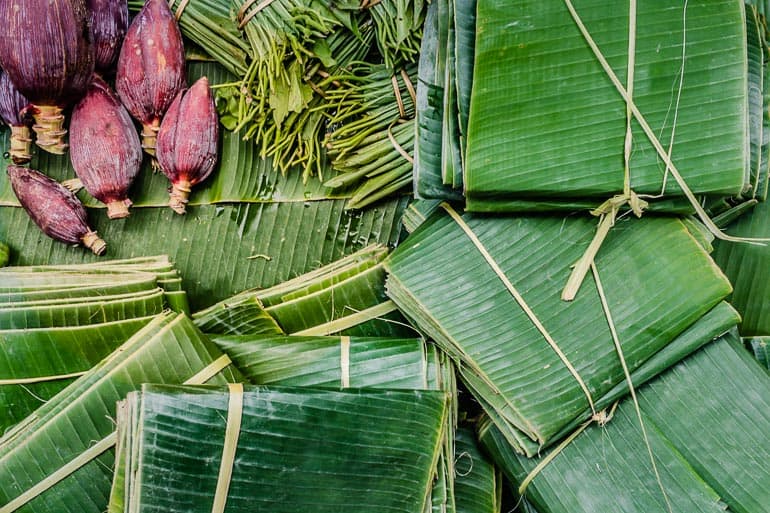
What are the usages of banana leaves?
The banana tree is native to Asia. It migrated to Africa and later to the Americas. Basically, it is grown throughout all the tropical and subtropical ranges. Its leaves are large, flexible, waterproof, and nonstick. Besides that, they are beautiful and always give a nice tropical touch.
It is no surprise that native people recognized the banana leaves as an opportunity to solve their needs and used it in a wide variety of uses for it. Whether for culinary, decorative, therapeutic, religious, or even construction and writing purposes.
How to cook with banana leaf
Although they are not edible, banana leaves have a very important role in the kitchen. It helps in almost every culinary process: preparation, service, consumption, and even packaging.
It can be used as:
Wrapping for steaming or baking
The banana leaf can hold the liquids of the food, being the perfect package to cook whatever you want, such as vegetables, fish, and chicken. Although the leaf is not consumed, it has a high antioxidant content, these antioxidants are absorbed by the food along with the aroma of the leaf.
There are many traditional dishes that use this technique around the world, such as the Mok Pa in Laos, Amok in Cambodia, Tamales in Mexico, Abará in Brazil.
Non-stick layer for grilling
The banana leaf prevents the food to stick on the grill. In addition, the leaf has the wonderful advantage of being porous and to be an alive element, so it adds a nice sweet and smoky flavor, something that the aluminum foil can’t do.
Bowl and boat shapes for baking or grilling
A mixture of the uses mentioned above. In Thailand, we tried Khai-Pam, a grilled omelet on the banana leaf that is amazing. Another example would be the Hor Mok, a steamed fish custard on a banana leaf bowl.
Non-stick paper for baking cakes and bread
This is how Bibingka is made in the Philippines. Bibingka is a rice and coconut cake that is baked in a cake pan covered with banana leaves. How about baking a loaf of bread on the banana leaf?
Takeaway or to-go packaging
Have you ever dreamed to find a biodegradable and inexpensive takeaway package? Banana leaves can be the solution to that. In Malaysia, Nasi lemak, one of the most traditional dishes, is sold in a triangular package made with banana leaf. The same happens in Indonesia with Nasi jinggo and nasi bantingan. Just open it and eat the food on the leaf itself.
Wrapper for food fermentation
For some foods, banana leaves are also a great element for aerobic fermentation. It allows air exchange while protecting the food and letting fermentation occur naturally. This is the method of making Kenkey, a dish from the northwest region of Africa, which is a corn dough fermented in banana leaves. In Vietnamese foods, we tried Nem Chua, fermented pork meat in banana leaf. Another good example is the Tempeh from Indonesia. Additionally, banana leaves are also used to cover cocoa during its fermentation.
A layer for covering plates
In Indonesia, it is very common for dishes to be served with a banana leaf mat on the plate. In this case, the banana leaf has two functions, besides being beautiful, does not let the plates get too dirty. It also contributes to consuming less water for the cleaning! By the way, some local and traditional restaurants called warung makan, use rattan baskets layered with a banana leaf to serve food instead of a regular plate.
They can also be the plate itself or even the tablecloth
In South India, there is a festive tradition called Sadhya where a whole feast is served on the banana leaf stretched on the floor. In this tradition, each portion such as rice, dhal, chutneys, and curries have their own specific spot on the leaf.
Anyways, you don’t need any specific date or ceremony to use the banana leaf in your food preparations. In Malaysia, there are many restaurants of Indian Malays known as Banana leaf (obvious name, right?) that serve rice and various side dishes on top of an individual leaf.
To wrap the leftover food
If it is used to cook, serve, and pack… why not store it? The banana leaf lasts a long time in the refrigerator and freezes very well.
To give a beautiful tropical touch to any plating and serving
Can you imagine how beautiful it would be to serve your meal on a banana leaf bowl? Also, origami made out of banana leaf can be used as decoration.

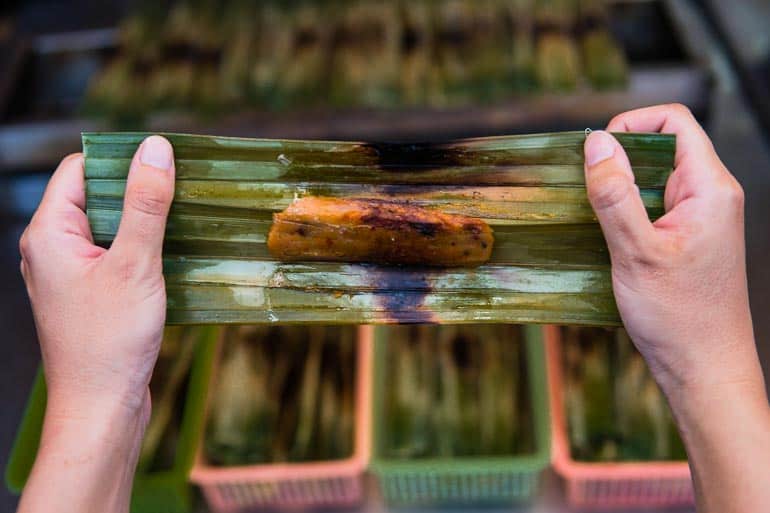
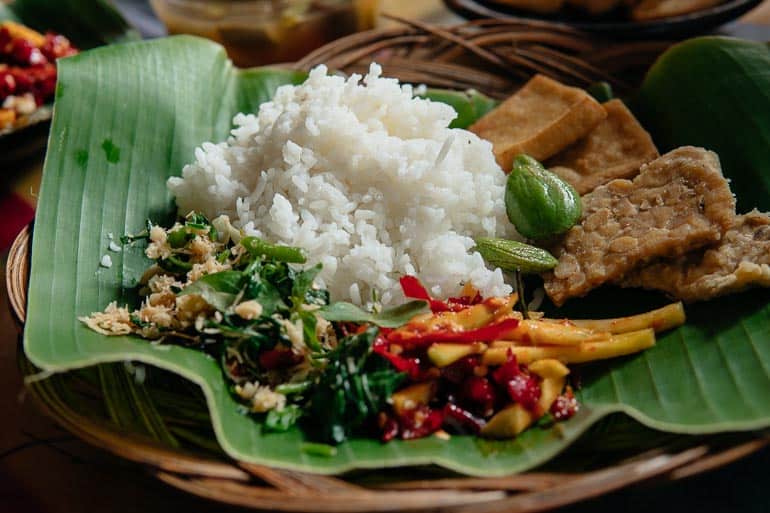
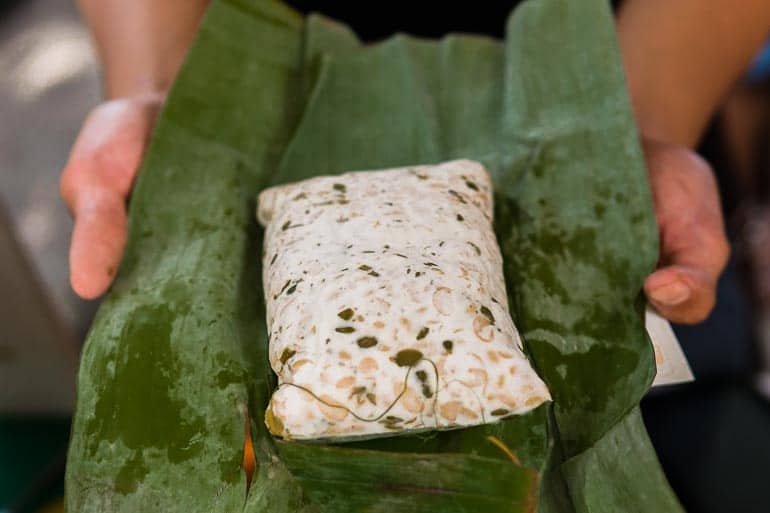
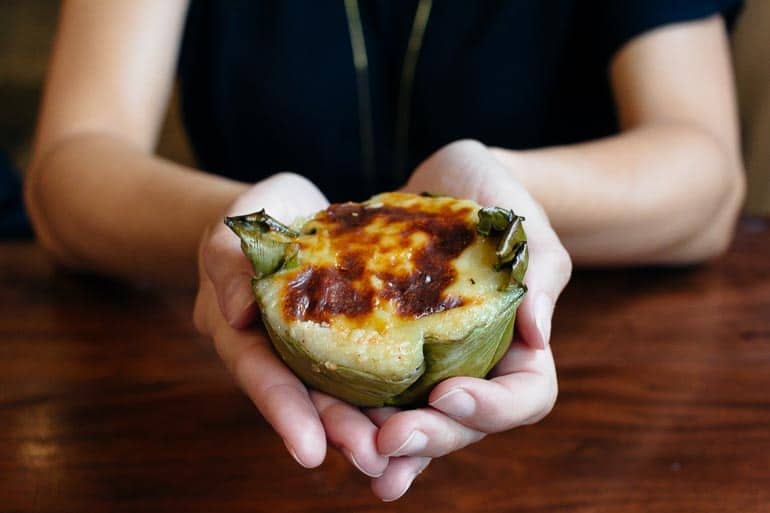
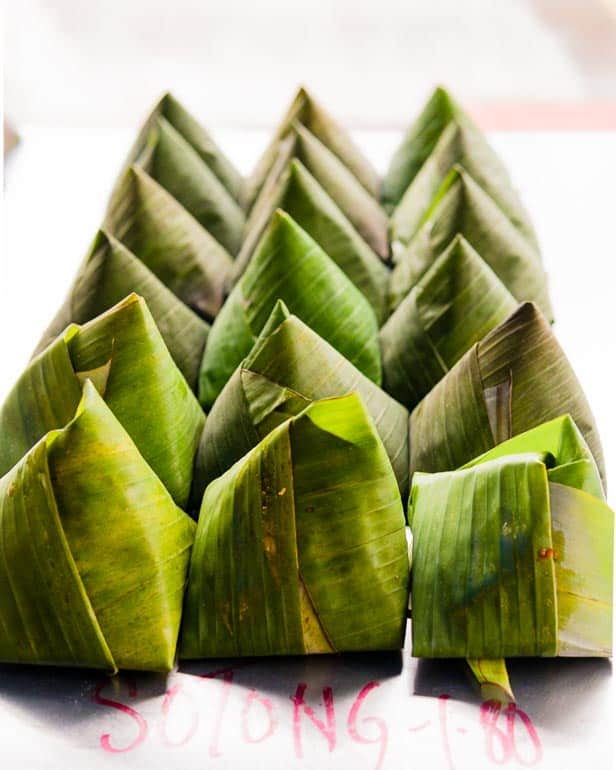
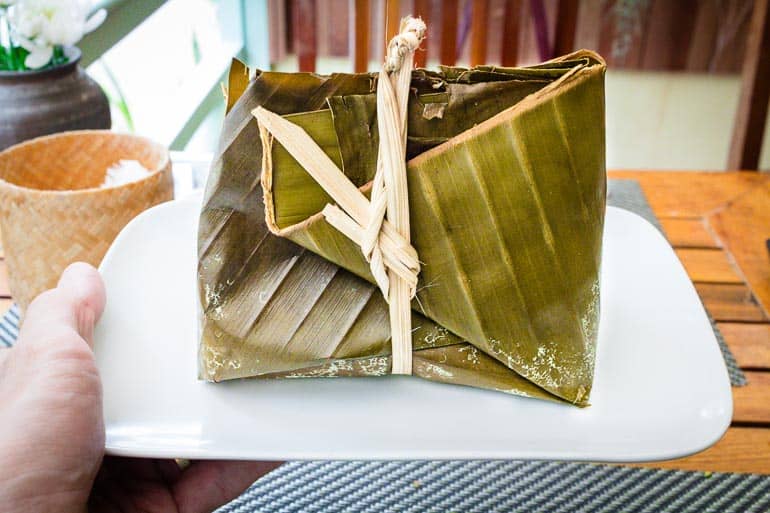





Tips to prepare the banana leaf for cooking
Before using the banana leaf, it is important to understand some of its characteristics. Did you know that banana trees are not a tree themselves but one giant herb? A banana leaf can reach more than 2 meters long. It has a central stalk (petiole) that divides the leaf into 2 blades. The top side of the sheet is brighter and the bottom side is more matte.
For most of the uses we have listed above, the two blades need to be separated from the central stalk. If you buy banana leaf in the market, this step will most probably be already done. Then, just follow the tips below:
- Clean the leaves in the direction of the fibres to reduce the risk of tearing it.
- Before use, boil it in water for some minutes or heat the leaves on the flame, so it will become flexible.
- When the leaves are detached from the central stalk, there is a fibrous part of the side that was attached. This “line” of fibre can be used to tie your packages.
- Cut into the size you need, tear the leaves with your hand in the direction of the fibre. If you want a specific format, use scissors.
- For steaming or baking, use a toothpick to close the wrapping. By doing this you avoid reopening itself.
- You can freeze the banana leaves. To do so, it is more practical to cut the leaf in smaller sizes. When you use it, just defrost at room temperature.
- If your recipe is too watery or has some sauce, it is better to consider a double layer of banana leaf. It can handle this type of preparation, but you don’t need to push it too much.
In favour of a world with more banana leaf
We want more banana leaves. Besides being very versatile, it is a cheap, biodegradable, and more beautiful alternative than aluminum and plastic film. Don‘t you think?
Imagine if its use expands from traditional dishes and native kitchens to cafeterias, food courts, and food trucks? The potential and benefits are more than clear!
